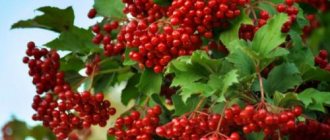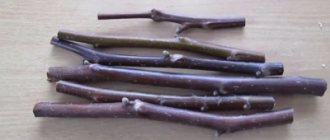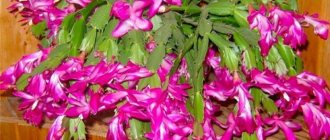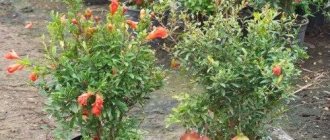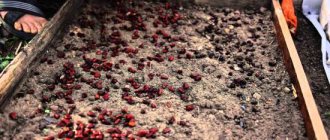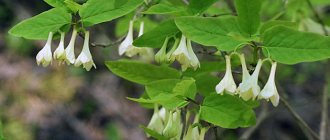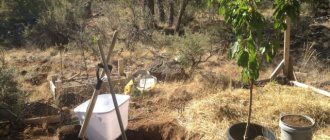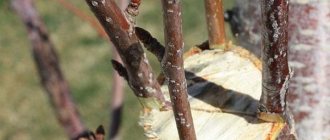Is it possible to propagate cherries from cuttings in summer?
This method is considered the fastest. Cuttings of cherries in summer occur by ordinary rooting in the ground or grafting onto wild rootstock .
The first method allows you to obtain your own rooted tree, the second - a cultivated variety with a more powerful, winter-hardy, unpretentious root system.
Many beginners are interested in whether it is possible to propagate cherries at home. Professional gardeners say that there is nothing difficult about this, and beginners should try the method of rooting cuttings in the ground (instructions are provided below).
Reference. Cuttings are used by gardeners who want to increase the number of fruit trees of their favorite variety or rejuvenate a perennial garden. At the same time, they save a significant amount of money on the purchase of seedlings.
Advantages and disadvantages
Advantages of propagating cherries by cuttings:
- experimenting with plant material;
- there is no need to use complex technical devices;
- preservation of the best characteristics of the variety;
- saving money.
Flaws:
- until rooting, cuttings need careful care;
- Without certain knowledge and experience, it is very difficult to get a new tree.
Common Mistakes
To get a quality plant, it is recommended to strictly follow all the necessary rules. When propagating cherries, inexperienced gardeners face various difficulties:
- The plant does not grow. The problem is usually caused by a lack of moisture or fertilizer.
- The seedling does not take root. First of all, it is important to make sure that it really has no roots. After this, it is recommended to take action. To do this, it is worth treating the cuttings with a healthy mixture or using mineral preparations.
- The cherry tree doesn't bloom. This is due to errors during planting work, excessive deepening of the root collar and other factors.
If problems arise, do not give up. First of all, it is recommended to establish the reasons for their occurrence and try to eliminate the provoking factor.
Suitable cherry varieties
The following varieties are considered good::
- Fatezh;
- Franz Joseph;
- Homestead yellow;
- Beauty of Kuban;
- General's;
- Dagestan;
- Tyutchevka.
The vigor of the tree is another problem that does not suit summer residents. The berries are too high and spoil quickly or are eaten by birds.
Therefore, the following low-growing varieties are valued :
- Colt;
- Maxma Delbar 14;
- Piku;
- Gisela.
It is good if the crop can withstand frosts , hot or rainy summers.
Interesting things on the site:
The best varieties of cherries for the Moscow region
Review of the best winter-hardy cherry varieties
What are the benefits of cherry-cherry hybrids?
Selection and preparation of cuttings
Green cuttings are prepared as follows:
- Choose a cool day.
- Well-developed shoots about 30 cm long are cut off.
- Leave 2-3 healthy leaves on each.
- The sections are immersed in Kornevin to stimulate root growth and kept in the solution for about 12 hours.
- Then put the material in clean water for 2 hours.
How do woody cuttings propagate?:
- Young mother plants are selected, in which the lower part of the shoots begins to become woody, while the upper part remains softer.
- Cut shoots 25-30 cm long with 3-4 growth buds.
- Place them in a bucket of water and moisten the leaves.
- After 2-3 hours, cut the blanks into cuttings 5-7 cm long with two internodes.
- Remove half of the leaf plates.
- Place the material in the “Heteroauxin” solution (250 g of the drug is diluted in 1 liter of water) to a depth of 2.5 cm.
- In the morning they drop off.
Cherry propagation by air layering is used very rarely when the mother tree is weak and the cutting does not take root in open ground. An incision is made on the fruiting branch. This place is wrapped in a plastic bag with earth. The soil is constantly watered. The branch will take root only after 2 years.
When procuring raw materials, beginners are advised to adhere to the following rules :
- Do not take cuttings from old trees. They won't take root.
- Choose material from cherries, the fruiting of which lasts 2-3 years.
- It is better to cut the lower, even, well-developed shoots from young, strong branches.
- Separate samples in the morning or evening after 18:00.
- Use only clean tools. Pre-treat the knife in a weak solution of potassium permanganate.
- Make the lower cut at an angle of 45°, and the upper cut at a straight angle.
Not only cherries are propagated using shoots . The method is chosen to obtain new cherry, plum, and apricot trees.
Ways to root them
The workpieces are rooted in two ways : by planting in the ground or by grafting.
How to grow cherries by planting in the ground:
- Prepare the greenhouse and soil. A good option is a greenhouse or mini-box. For the substrate, take equal parts of peat and river sand.
- Place the mixture on the bed in a layer of 12 cm and carefully level it. A 1.5 cm layer of sand is poured on top.
- The soil is moistened. Then the prepared cuttings are planted.
To propagate cherries by grafting, the bark method is used.
The rules are as follows:
- For the rootstock, choose a healthy branch of plum, apricot, cherry or another variety of cherry.
- Using a clean, sharp knife, separate the upper part of the rootstock so that the length of the working material is 30-45 cm.
- Make a longitudinal incision in the bark and carefully separate it from the wood.
- An oblique cut is made on the scion so that 15 cm and 2 healthy buds remain.
- The cutting is inserted into the cut of the mother branch with the cut side inward.
- The parts are wrapped with polyethylene, and the open areas are treated with wood ash.
The vaccination is performed in cloudy weather in the afternoon, no later than June 15.
Cultivation by shoots
The method of propagating cherries by shoots is considered the most relevant and easiest. This species is in particular demand among breeders in the northern regions of the country, where cold and wet climatic conditions prevail.
Rules for selecting shoots:
- only strong and healthy shoots are selected, weak ones will not take root in a new place;
- You should not plant plants that grow close to each other: they will not take root deep enough;
- perennials are also not suitable, because when transplanting, the root system can be severely damaged, which will jeopardize the further development of the fruit tree or lead to its death.
To grow a healthy, strong tree, you should choose high-quality material for propagation by shoots. Shoots that are no more than 2 years old, with a well-developed crown and rhizome, are ideal. The cuttings should grow at some distance from the mother tree, then you can be sure that in the future they will become excellent adult plants.
The technology of propagation by shoots is presented below.
- First, a suitable shoot is selected and a distance of 25 cm from the trunk is measured, the root that connects the shoot to the mother tree is cut down. The work can be done using a shovel or other convenient tools.
- It is imperative to apply mineral fertilizers to the mother tree and aerate the soil to saturate it with oxygen and to prevent the growth of weeds around the fruit tree.
- The shoot should be left to grow in the summer, during which time it will take root, become stronger and be ready for autumn replanting in the garden.
Planting ready-made cuttings
The cuttings are planted in a temporary area according to a 70x70 cm pattern . Water generously. Cover with polyethylene to protect from sunlight. The seedlings are left until next spring. During this time, they will have time to gain strength and form a powerful root system.
Cherries are transplanted to a permanent location at the end of May . Maintain a distance between trees of 1 to 1.5 m. Care for them as for an adult shrub.
Reproduction using seeds
In order to choose the optimal propagation method for you, you should consider the following method. The method of growing cherries from pits is used in spring, autumn and summer, when they are easily separated from the pulp.
The seeds are thoroughly washed using manganese and, without drying, placed in a humid environment. After which the soil is prepared by loosening it and treating it with organic fertilizers. Sowing is carried out to a depth of four centimeters, in holes placed at a distance of a maximum of thirty centimeters.
In spring, in its first days, the seeds sprout. Thin out the shoots, leaving only the strong ones. If you plan to plant the seeds in the spring, place them in a humid environment for four months, pre-soaking them for five days, changing the water every day.
Reproduction using seeds
The environment where the cherry pits are placed must be constantly moist and ventilated. The temperature is maintained at least fifteen degrees. After this, they are placed in a cold room with a temperature of about six degrees. There they are stored until they germinate. The emerging sprouts are transferred to the snow until the end of winter; in the spring they are transplanted into the ground.
Features of cuttings depending on the type of cherry
The cutting methods described earlier are suitable for any type of cherry . The main thing is to follow the general rules for harvesting and subsequent planting.
Depending on the region
In the southern regions, cuttings are carried out from June 1 to June 15, but no later.
In the middle zone and northern areas - no later than July 10. But in the latter case, experienced gardeners recommend harvesting cuttings in the fall, leaving them in a container with soil until spring.
Contraindications
Cherry decoction has no serious contraindications, but still, before brewing cherry twigs and leaves, you should consult a doctor, especially if you have chronic diseases.
But even if the doctor gives the go-ahead, it is better to start with small doses and observe how you feel. The decoction should not be consumed:
- people with high acidity, stomach ulcers and gastritis in the acute stage;
- with inflammatory processes in the lungs;
- with unstable bowel function;
- at low blood pressure;
- with increased individual intolerance.
Further care
The process of rooting a tree cutting lasts up to 6 weeks . It is considered difficult because the shoot has no roots and needs constant heat and high humidity.
Care is as follows:
- Maintaining optimal day and night temperatures. New trees are germinated in closed greenhouses. They are opened a crack every week. Monitor the temperature: optimal values day and night are from +20 to +27°C.
- Regular abundant watering. Do not allow the soil to become waterlogged, otherwise the lower part will begin to rot and the root formation process will stop. Water as the top layer of soil dries. Up to 3 liters of water are poured under one cutting.
- Avoiding drying out of seedlings. They are sprayed in hot weather with soft, slightly warmed water. In winter, the soil near the cuttings is covered with a thick layer of peat or fallen leaves. After the snow appears, rake a high snowdrift and make sure that an ice crust does not form on it. In spring, the soil around the seedling is compacted, watered abundantly with warm water and a layer of mulch is laid again.
- Feeding. Only those cherries that have successfully overwintered are fed. The earth is watered and 2.2 g of superphosphate per 1 square meter is added. m plot. Feed 2-3 times throughout the season.
Care measures are carried out for another 1 year, and then the young cherries are transplanted to a permanent place. The buds that appear are removed. Care for the plant as for an adult tree.
Advice from experienced gardeners
Cuttings require taking into account the following recommendations:
- Only a healthy mother tree is selected. Otherwise, diseases of adult cherries will spread to young ones.
- Comply with care measures. Control the temperature and irrigation regime.
- In the southern regions, cuttings are harvested no later than June 15. In the northern regions they prefer to perform the procedure in the fall.
- Separate the lower branches. The cut area is sprinkled with ash.
- Use only clean, sharp tools.
Application of grafting
Cherry propagation involves another effective method called budding. To carry it out, two-year-old wild seedlings are used, into which the best varieties are grafted, with improved taste, yield volumes and endurance characteristics. Cherry grafting is the least difficult process to perform. Which is best done in the spring.
Cherry grafting using copulation method
In early winter, in the northern regions, young shoots are prepared, and in the southern regions, shoots are prepared before budding. The shoot is removed from the tree and placed in warm water for a while. After which a number of shoots are cut from it so that each has up to four buds. To prevent the shoots from drying out, they are treated with a solution extracted from a molten candle. Or cover the shoot with film until it grows into the grafted tree.
Copulation is carried out until spring. This variety matches all varieties. Cherry grafting is a frequently used and not labor-intensive process for home use.
Cherry bud grafting
